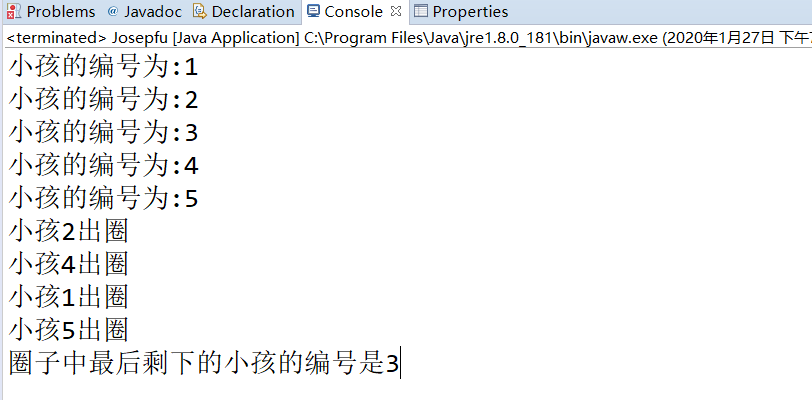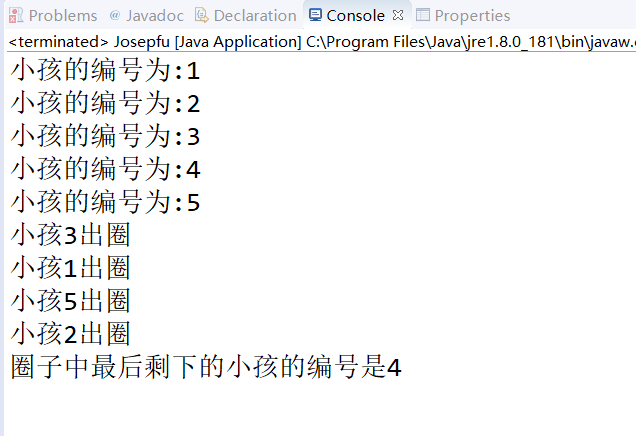Josephu problem
Joseph u problem is: set the number to 1, 2 N people of N sit around for a circle, and the number of K (1<=k<=n) people is agreed to count from 1
, the one who counts to m will be listed, and the next one will report from 1. The one who counts to m will be listed again,
And so on, until all the people are listed, resulting in a sequence of queue numbers.
Tip: use a circular list without leading nodes to handle the Joseph problem:
First, a single cycle list with n nodes is constructed, and then counting from 1 to m from k nodes
The corresponding node is deleted from the list, and then the next node of the deleted node is counted from 1,
Until the last node is deleted from the list.
code implementation
package com.atguigu.linkedList;
public class Josepfu {
public static void main(String[] args) {
//Test traversal and creation methods
CircleSingleLinkedList circleSingleLinkedList = new CircleSingleLinkedList();
circleSingleLinkedList.addBoy(5);
circleSingleLinkedList.showBoy();
//Test circles circleSingleLinkedList.countBoy(1, 2, 5); }
}
//Create a circular single linked list
class CircleSingleLinkedList{
//Create a first node, currently there is no number
private Boy first=null;
//Add nodes and build a circular list
public void addBoy(int nums) {
//A simple data check by nums
if(nums<1) {
System.out.println("Nums has an incorrect value");
return;
}
Boy curBoy=null;
for(int i=1;i<=nums;i++) {
Boy boy=new Boy(i);
//If it's the first kid
if(i==1) {
first=boy;
first.setNext(first);
curBoy=first;
}else {
curBoy.setNext(boy);
boy.setNext(first);
curBoy=boy;
}
}
}
//Traverse the current ring list
public void showBoy() {
//Judge whether the list is empty
if(first==null) {
System.out.println("Empty table");
return;
}
//Because first can't move, we still use one
//Auxiliary pointer to complete traversal
Boy curBoy=first;
while(true) {
System.out.printf("The number of the child is:%d\n",curBoy.getNo());
if(curBoy.getNext()==first) {
break;//The description has been traversed
}
curBoy=curBoy.getNext();
}
}
//According to the user's input, calculate the order of circles
/*startNo:It means counting from the first child
* countNum How many times
* nums How many children were in the circle at first
*
* */
public void countBoy(int startNo,int countNum,int nums){
//Verify the data first
if(first==null||startNo<1||startNo>nums) {
System.out.println("There is a problem with parameter input. Please input again");
return;
}
//Create auxiliary variables to help children out of circles
Boy helper=first;
//helper, should point to the last node of the circular list in advance
while(true) {
if(helper.getNext()==first) {
break;
}
helper=helper.getNext();
}
//Let first and helper move startNo-1 times (that is to say, move to the kid who reports the number) before the kid reports the number
for(int j=0;j<startNo-1;j++) {
helper=helper.getNext();
first=first.getNext();
}
//When the child reports, let first, helper move countNum-1 times
//Then get ready to go out of the circle. It's a repetitive process until there's only one person in the circle
while(true) {
if(helper==first) {
break;
}
for(int j=0;j<countNum-1;j++) {
helper=helper.getNext();
first=first.getNext();
}
//The first node is the node that needs to be circled
System.out.printf("Child%d Circle out\n",first.getNo());
first=first.getNext();
helper.setNext(first);
}
System.out.printf("The number of the last remaining children in the circle is%d\n",first.getNo());
}
}
//Create a Boy class to represent a node
class Boy{
private int no; / / No
private Boy next; / / points to the next node
public Boy() {}
public Boy(int no) {
this.no=no;
}
public int getNo() {
return no;
}
public void setNo(int no) {
this.no = no;
}
public Boy getNext() {
return next;
}
public void setNext(Boy next) {
this.next = next;
}
}
Operation result
 It is intuitionistic and easy to understand to solve Joseph's problem with the idea of circular chain list. I hope this article can help you.
It is intuitionistic and easy to understand to solve Joseph's problem with the idea of circular chain list. I hope this article can help you.

